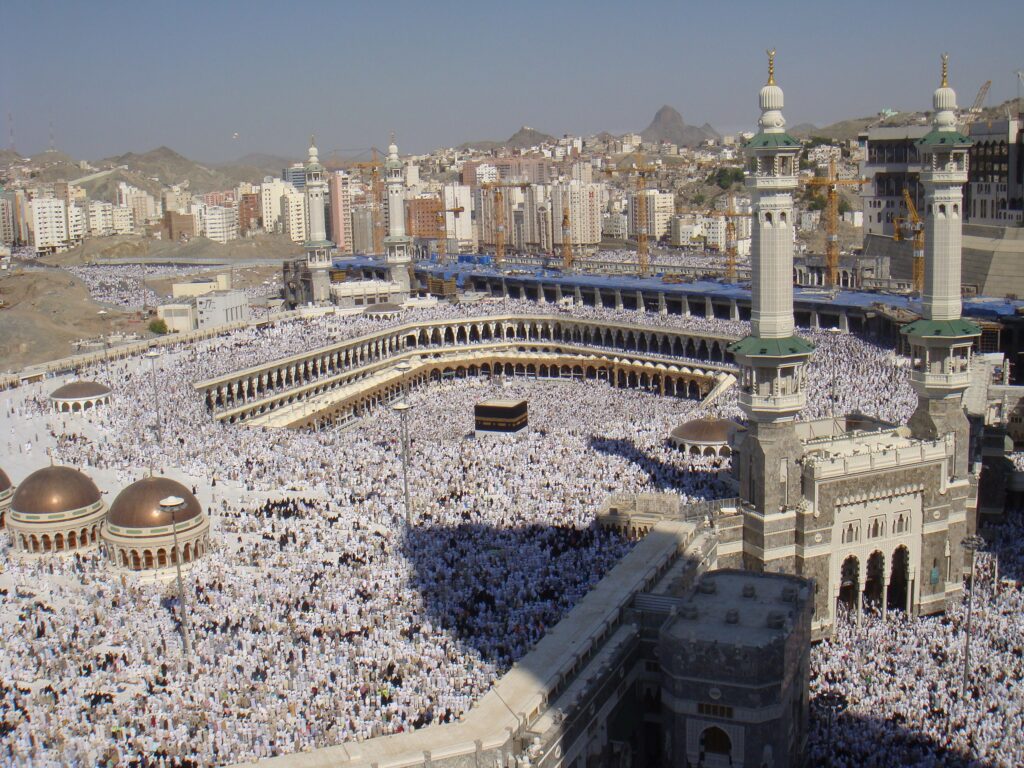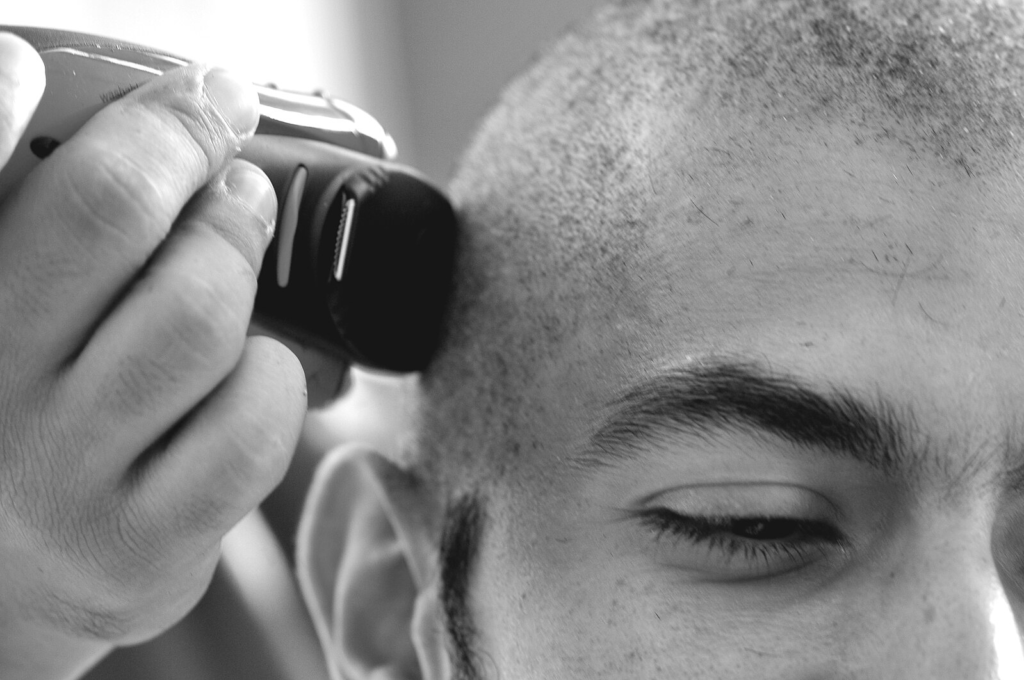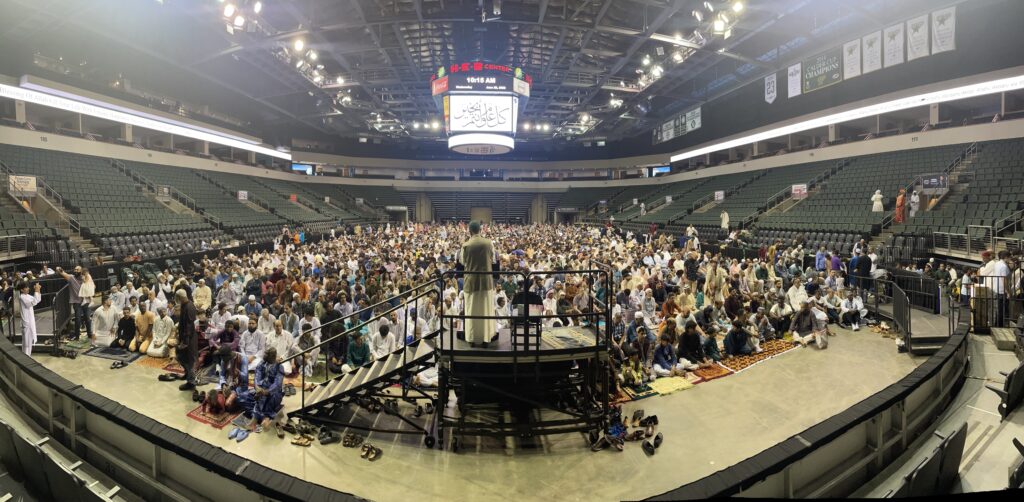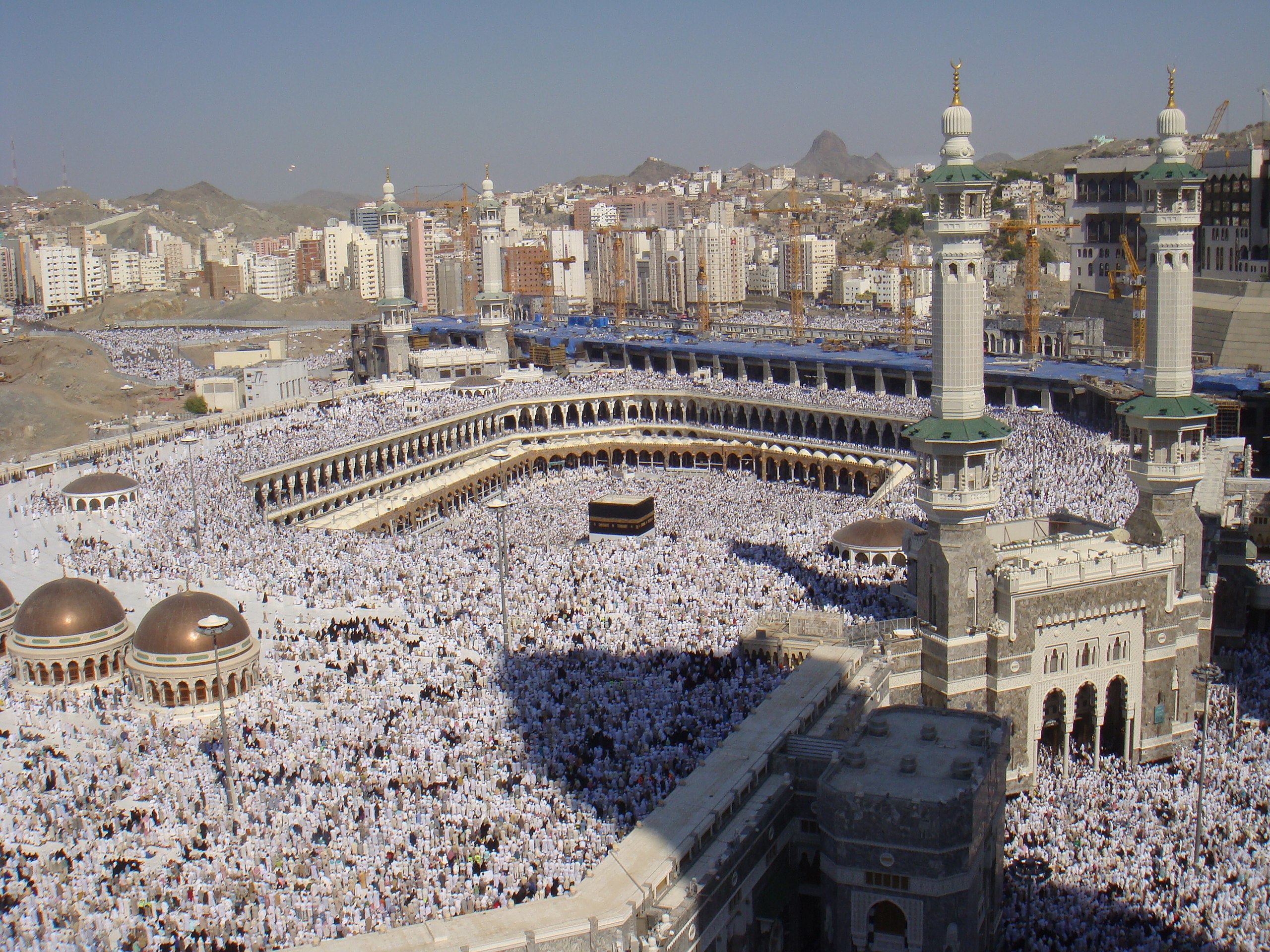
Today, June 28, 2023, is Eid al-Adha, one of two major Islamic holidays celebrated each year. (Photo credit: By Al Jazeera English – Al-Haram mosque, CC BY-SA 2.0, https://commons.wikimedia.org/w/index.php?curid=17512722)
Fiction is full of many life-changing stories. As Joseph Campbell lays down in The Hero’s Journey, a hero goes through a rigorous, often dangerous, journey and comes out with a new beginning—a new vigor and deeper understanding of their mission. In other words, completely transformed.
We rarely see these examples in real life. One such real-life transformation happened in the 1960s to the firebrand spokesman of the Nation of Islam, Malcolm X, when he completed the major pilgrimage to Mecca called the Hajj. He went in as Malcolm X and came back as Al-Hajj Malik El-Shabazz. (Al Hajj or Haji is the title for someone who completed the Hajj).

Malcolm X meeting with then Crown Prince Faisal Al-Saud in Jeddah, April 1964, prior to his pilgrimage. Photo credit: commons.wikimedia.org/wiki/File:Malcolm_X_with_Faisal_bin_Abdulaziz
One of the good things about Malcolm X was that he poured his heart out in writing as he was going through major events. His letter from Mecca gives glimpses of his Hajj transformation. This excerpt from his writing describes his experience of transformation during the pilgrimage:
“You may be shocked by these words coming from me. But on this pilgrimage, what I have seen, and experienced, has forced me to rearrange much of my thought-patterns previously held, and to toss aside some of my previous conclusions. This was not too difficult for me. Despite my firm convictions, I have always been a man who tries to face facts, and to accept the reality of life as new experience and new knowledge unfolds it. I have always kept an open mind, which is necessary to the flexibility that must go hand in hand with every form of intelligent search for truth.
During the past eleven days here in the Muslim world, I have eaten from the same plate, drunk from the same glass, and slept on the same rug – while praying to the same God – with fellow Muslims, whose eyes were the bluest of blue, whose hair was the blondest of blond, and whose skin was the whitest of white. And in the words and in the deeds of the white Muslims, I felt the same sincerity that I felt among the black African Muslims of Nigeria, Sudan and Ghana.
We were truly all the same (brothers) – because their belief in one God had removed the white from their minds, the white from their behavior, and the white from their attitude.” (Source)
Muslims perform the Hajj as one of the five foundational pillars of Islam—the main obligations that every Muslim must fulfill to live a responsible life. The other four obligations are the declaration of faith to one God (Shahada), daily prayers (Salat), charity (Zakat), and fasting during Ramadan (Sawm). Most Muslims hope to make the Hajj, this physically and mentally challenging but rewarding journey, at least once in their lifetime as long as they are physically and financially able. This year, it is even more challenging with temperatures rising close to 110 degrees of open-desert heat. Those who complete the Hajj often say that it is a life-changing experience, as Malcolm X did. It is a time for Muslims to renew and rededicate their faith and to connect with their spiritual side, a time to show solidarity with other Muslims from all over the world, and a time to ask for forgiveness for their sins and to make a fresh start. Through the Hajj, Muslims get to experience the beauty of Islam and the power of their faith, to connect with their roots, and to feel the love of Allah and Prophet Mohammed.
I performed my Hajj with my parents and extended family when I was in seventh grade, in the early 1980s. I am still due one since that first time was considered completed as a minor. I have visited Mecca several times—when I was growing up and as an adult, with my last visit in 2007—and performed the minor pilgrimage called the Umrah a few times. While the minor pilgrimage can be performed at any time of the year and completed within a few hours, the Hajj is done only once a year, in the last month of the Islamic calendar called Dhul Hajjah (month of Hajj), and takes about five to six days. About two to three million people are expected each year. Most of the media now cover the Hajj—Al Jazeera has done a great job detailing the process here.
Muslim pilgrims from all over the world arrive in Mecca on the seventh day of Dhul-Hajjah—falling on June 25th this year—and set their intention to perform the Hajj. In Islam, a lot of practices are intention-driven (yes, Dr. Wayne, I am thinking of you). The Hajj pilgrims are required to enter Mecca in the purified and simple state of ihram. The state of ihram is a symbol of humility and spiritual focus, serving to unify pilgrims from different backgrounds and economic status. For men, this means wearing two pieces of white cloth only—one piece wrapped around the waist and another draped over the left shoulder, with the right shoulder bare at all times. Kinda like monks. Very austere for the rich and poor. Women can wear any plain clothing of their choice but should observe the rules of hijab and cannot cover their faces. Many men shave their heads as a sign of rebirth at the end of Hajj.

Trimming of hair or, for men, shaving their heads, is part of completing the Hajj pilgrimage. (Photo credit)
The ninth day of Dhul Hajjah is considered very holy, as the last sermon by Prophet Mohammed was also given on this day where he proclaimed that “today you have received the perfect religion,” and urged followers to keep its purity in future generations. Many Muslims fast on this day.
This day is then followed by Eid al-Adha. Remember my previous post here about how Islam is part of the Abrahamic tradition? Eid al-Adha, or the Festival of Sacrifice, is celebrated to commemorate the willingness of Ibrahim (Abraham) to sacrifice his son Ismail as an act of obedience to Allah. According to Islamic tradition, before Ibrahim could sacrifice his son, God provided him with a ram to sacrifice instead. That is why Muslims sacrifice (Udhiya/Qurbani) a goat, cow, or camel. A large portion of the meat is distributed to needy along with feasting with friends and family. Muslims believe that this act of obedience and sacrifice epitomizes the true meaning of faith and devotion to Allah. Eid al-Adha is a time for Muslims to come together with family and friends to celebrate their faith and to give thanks to Allah for all of his blessings. It is also a time for Muslims to show their generosity and to help those in need with gifts, including clothes and food. The main theme of this month is sacrifice while the theme is Ramadan is focused on piety and renewal. The idea of sacrifice, or the ability to give something in return for the blessings, is deeply embedded throughout out the Hajj and Eid al-Adha.

Eid prayer service today, June 28, at the HEB Center in Cedar Park, TX. (Photo credit: Shakeel Rashed)
This Wednesday, on June 28, we celebrate Eid al-Adha in Austin, among many other places in the world. Each place has its different flavor. Many regions, including Austin, perform this Eid in sync with Mecca as the Hajj is celebrated globally. The Muslim population in Austin has increased to the point that, even with six prayer services during a work day, we still need more.
If you know any Muslims, please wish them a Happy Eid al-Adha this week—it’s one of the two major holidays of the year.


3 Responses
Fascinating. Thank you for sharing this information and your story.
Most welcome Bess
Thank you for this post!